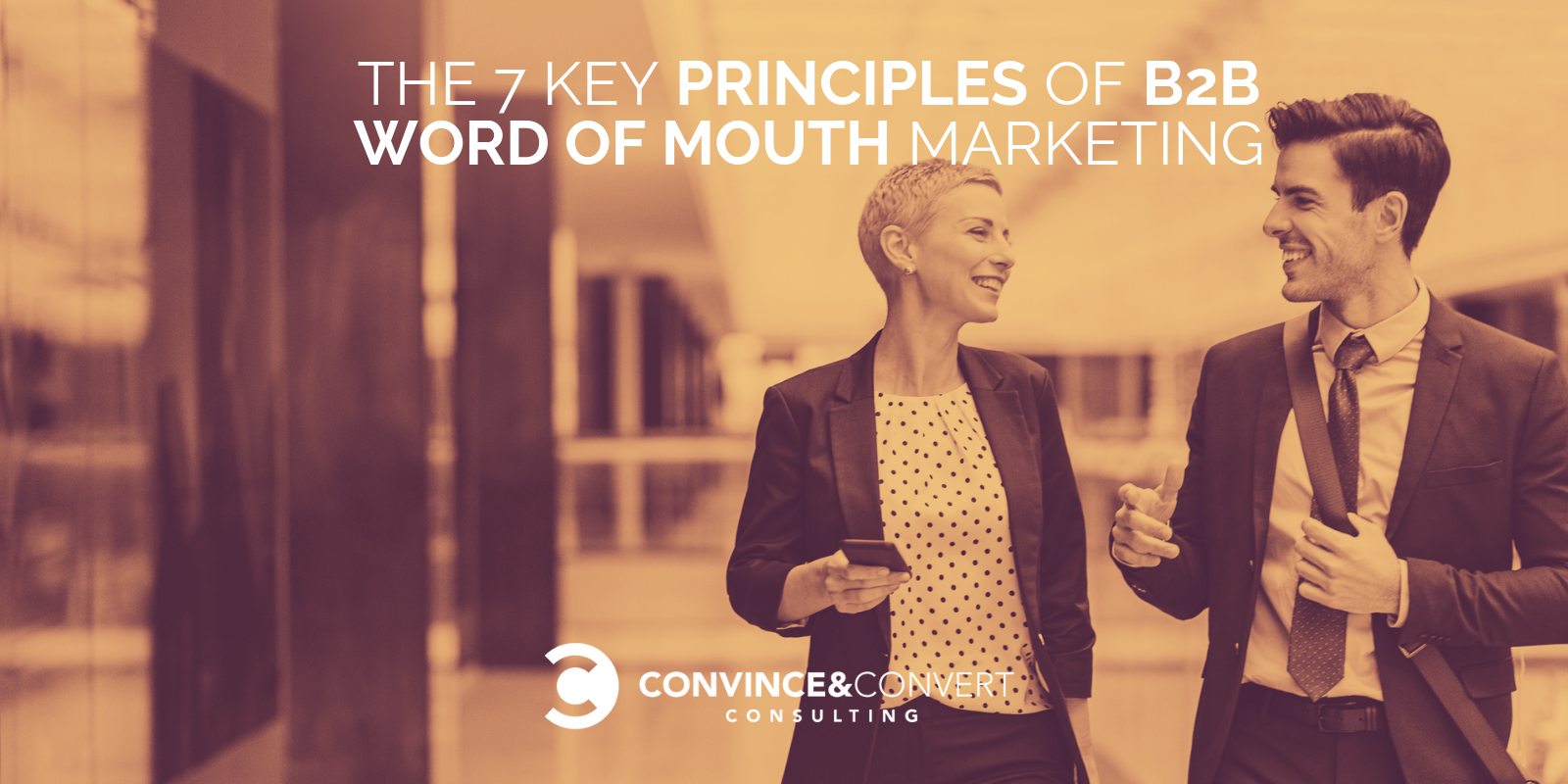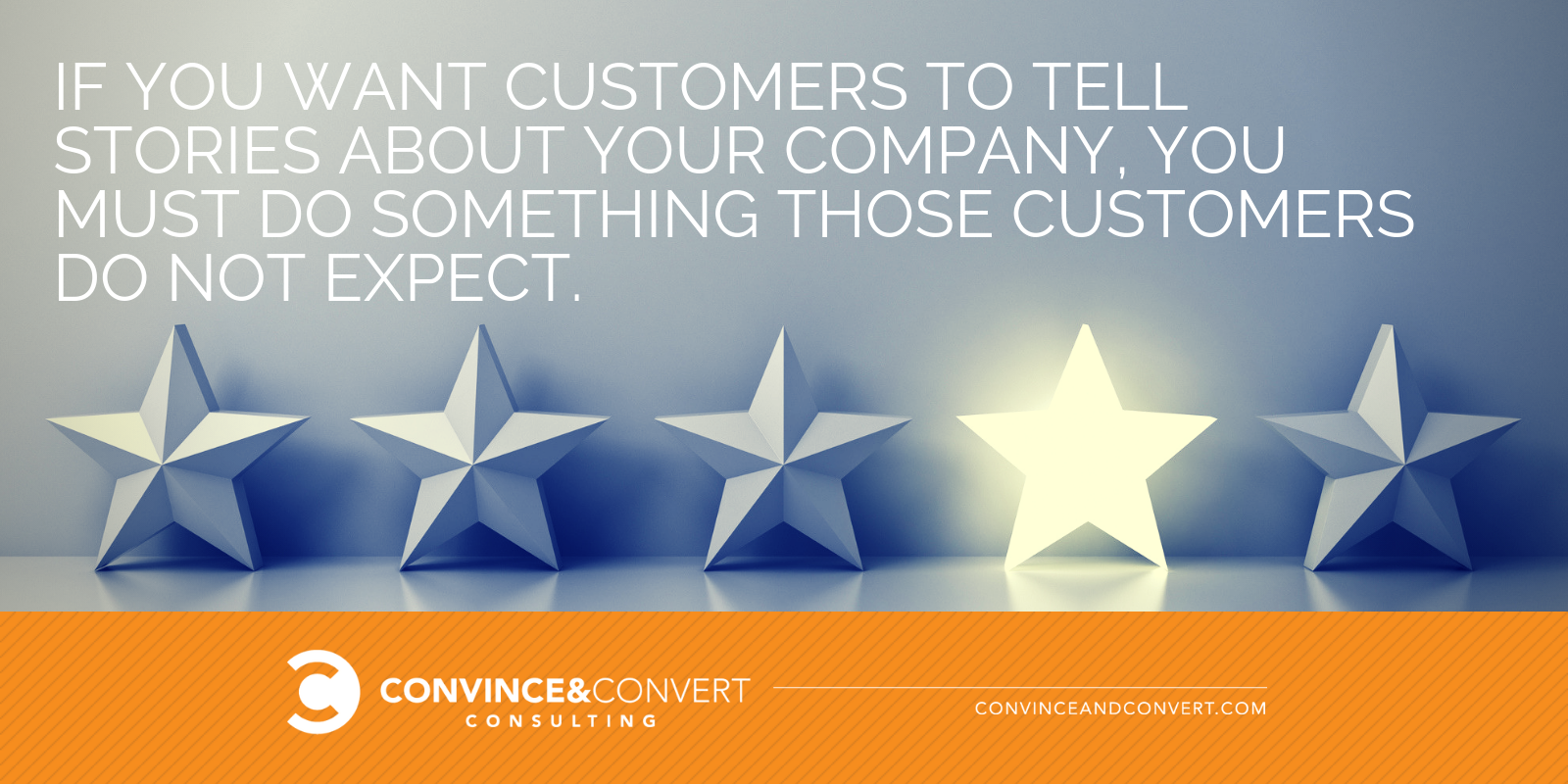
The best way to grow any company is for the customers of that company to do the growing for you. Word of mouth is the most effective (and cost-effective) method of customer acquisition and growth.
In B2B, word of mouth is exceptionally important:
91% of B2B purchases are influenced by word of mouth.
Click To Tweet
.
Why is word of mouth so vital in B2B companies? The relative expense of most B2B purchases outweighs B2C buys. Thus, there is a greater risk associated with B2B decision making. And when risk is higher, customers seek to avoid mistakes. And a primary way buyers avoid mistakes is by seeking the opinions of current customers, via online and offline word of mouth recommendations and referrals.
But what’s fascinating to me is that we know this to be true, in our gut. OF COURSE, word of mouth is important for B2B. Yet, very few companies have an actual strategy for generating customer conversations.
Word of mouth just may be the most important element of B2B success, but scant attention is actually paid to it. Remarkable!
Last week, I had the pleasure of conducting a half-day workshop on Talk Triggers and B2B word of mouth marketing, in cooperation with our friends at Desantis Breindel, a terrific B2B branding agency located in New York City.
They brought together an interesting collection of B2B marketing leaders from a variety of industries, including health care, law, finance and beyond.
I won’t go through the entire workshop here, as that would be pretty lengthy. (If you’re interested in a workshop of your own, let us know.) Meanwhile, here are 7 key principles of B2B word of mouth marketing.
1. B2B Word of Mouth Must be Purposeful
Most (nearly all) companies take a puzzling laissez-faire approach to word of mouth. They just assume that customers will take about the business. But will they? And if so, what are they saying?
Given the importance of word of mouth in B2B (see 91% figure above), is it wise to be lax about word of mouth strategy?
Our philosophy at Convince & Convert is that all brands can (and should) do word of mouth on purpose, by figuring out an effective Talk Trigger. A Talk Trigger is a strategic, operational differentiator that compels word of mouth, reliably creating customer chatter on an ongoing basis.
2. Talk Triggers Aren’t Really Marketing
A Talk Trigger is something that you DO differently in your business, not something you SAY different in your business.
A Talk Trigger is not classic marketing. It’s not a price or a promotion. It’s not a contest or a coupon. It’s an operational choice that subsequently produces a marketing advantage by turning customers into volunteer marketers.
Freshbooks, for example, is a B2B accounting software company. Their Talk Trigger is their series of free events called I Make a Living. These events help connect their freelancer customers to the broader community, and to Freshbooks. They create a LOT of conversation.
Kudos to @freshbooks for an outstanding and thought-provoking event on how we make the future (with @monikabielskyte) in Toronto tonight! #imakealiving
— Anne Kavanagh (@anne_kavanagh) October 31, 2018
Absolutely insightful, engaging and thought provoking keynote by @monikabielskyte at @freshbooks #imakealiving . Thank you pic.twitter.com/3Y2sH46y6M
— TorontoDiana (@TorontoDiana) October 30, 2018
3. Same is Lame
Many B2B companies play follow the leader. They analyze and evaluate which companies are flourishing in their category or market, and then try to mimic the best characteristics of that brand. This makes sense, as it reduces risk. If it ain’t broke, don’t fix it, and so forth.
But the problem with that approach is that it doesn’t create any chatter.
Competency doesn’t create conversations. You’ve never called a friend and told them, “Guess what? I flicked a switch and … a light turned on!”
Competency reduces churn and prevents customer defection. But it doesn’t give customers the urge to tell a story about the business, which is the coin of the word of mouth realm.
If you want customers to reliably tell stories about the company, the firm must do something those customers do NOT expect. The best B2B organizations choose to do just one thing different in the operations of the company, and in making that choice, they end up with a Talk Trigger that powers their word of mouth strategy.

Think about Uberconference. This free conference calling service is essentially the same as any other company in the category. Except for the Talk Trigger, which is hilarious on-hold music, written and performed by their CEO, that creates a TON of chatter about the company, online and offline.
my most listened-to song of 2018: the @uberconference hold song.
— Kelly Burns (@kellyaburns) February 12, 2018
The @uberconference hold song is literally a country song called “On Hold” written solely for the purpose of being on hold. This is the greatest thing ever. #uberconference
— TK (@createdbytk) November 22, 2017
I’m on hold for an @uberconference call and the music is pretty darn entertaining. I gotta know who came up with this idea.
— Todd Budin (@budin_todd) January 17, 2018
4. Consistency is Key in B2B Word of Mouth
In addition to the curse of following the leader, one of the other traps B2B companies fall into is believing that, because competition for attention is fierce, they must do something really BIG to break through.
This is why you see so many brands trying their hand at “surprise and delight” these days. Surprise and delight is where you take one customer, in a particular circumstance, and you treat that customer much differently than the rest. Hotels do this a lot. Some guy checks into the Hyatt and finds a live, panda bear sitting on the bed, with a bamboo tree nearby.
The premise is that this one customer will be so surprised and delighted by this unexpected encounter that he will talk about it in social media. It will then go viral, and eventually jump from Reddit (or some such) to the traditional press, earning the hotel lots of attention along the way.
This might work.
Or, you just end up with an upset customer and panda scat in your hotel.
As I mentioned at this workshop, my team and I are not against surprise and delight as a tactic. But let’s call it what it is: a publicity stunt. It’s NOT a word of mouth strategy, because it’s not reliable or repeatable or scalable.
Surprise and delight and “going viral” are lottery tickets, not strategic plans for B2B word of mouth.
5. The Worst Way to Create a Talk Trigger
The least effective approach to word of mouth strategy is the one that almost everyone attempts:
Getting everyone in the conference room to brainstorm a differentiator that will create customer chatter.
If it was that easy, the Talk Trigger would already exist. If effective word of mouth strategy was simply a matter of getting some smart folks together with some donuts and riffing until gold appears, EVERY company would have a word of mouth strategy instead of ZERO companies having a word of mouth strategy.
The best way to create a Talk Trigger is the hard way: research, process, customer interviews, trial, and optimization.
We use a six-step process when creating word of mouth strategy for clients. It’s the same process we document in the Talk Triggers book.
The single most important component of that process is the customer interviews. B2B companies simply must talk to their customers (we recommend 15 interviews across three customer segments) to determine what buyers expect today at each step of the customer journey.
Once you know what people expect, you then know what they do NOT expect. And that’s where the Talk Trigger lives: in the land of the unexpected.
6. B2B Word of Mouth is a 50/50 Proposition (at best)
One of my favorite research projects we conducted for the book looked at customer attitudes about word of mouth and company differentiators.
We found that in the best case scenario, 47% of customers might conceivably converse about a Talk Trigger.
These are the Uniqueness Seekers (25% of the population) and the Experience Advisors (22% of the population). These two groups are particularly delighted about something unusual or disproportionately predisposed to recommending things to other people.
The other two customer segments are the Fundamentals Fans and the Skeptics. These two groups are unlikely to become volunteer marketers and tell someone else about a business that does something different. The first group is not at all enchanted by differentiators, and the latter believes that anything different is probably a gimmick or a trick.
What this means is that expectations for word of mouth in B2B must be reasonable and realistic. The most successful program in the world will find approximately half of all customers talking about it. That doesn’t at all diminish the importance of word of mouth, and in fact, accentuates the critical nature of creating chatter among that 47%.
Related post: The 3 Types of Customers That Will Talk About Your Business
7. Measuring B2B Word of Mouth
Like with anything that happens at least partially offline, it can be difficult to attribute specific sales to word of mouth, unless the company has a defined customer referral program. Outside of that, however, here’s how we recommend measuring word of mouth efficacy: with the three question survey.
Ask every customer (or every nth customer, if you must) three questions. Ask these questions once they’ve made the purchase and have definitely experienced whatever the Talk Trigger is for the company. If possible, ask every customer these questions at approximately the same post-trigger exposure interval, to eliminate recency bias.
In many cases, B2B companies will ask these questions by tagging them onto an existing Net Promoter Score survey, or other customer satisfaction gauge.
Question 1: Online or offline, how many people have you told about your experiences with our company?
Here, you’re trying to gauge actual information exchange, and whether this customer is likely to engage in word of mouth, or already has.
Question 2: What did you say?
Here, you’re looking for mention of the Talk Trigger. This would be an unaided mention.
Question 3: Did you talk about any of these things?
Here, you present a list of company characteristics, each with a checkbox. Seven characteristics should be listed, one of which is the Talk Trigger. You’re looking for mention of the Talk Trigger in a prompted, aided list.
There is a LOT MORE to successful B2B word of mouth than I’ve covered here, but I wanted to give you a good summary of some of the key pieces, drawn from my workshop with Desantis Breindel.
If you have questions, or we can help you, find me in social media or contact us here.
The post The 7 Key Principles of B2B Word of Mouth Marketing appeared first on Convince and Convert: Social Media Consulting and Content Marketing Consulting.
from Convince and Convert: Social Media Consulting and Content Marketing Consulting https://ift.tt/2PpXTbe




No comments:
Post a Comment